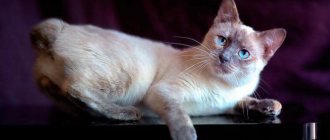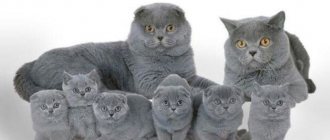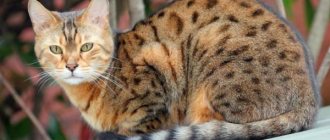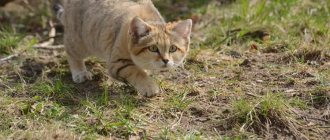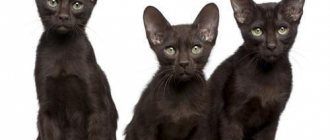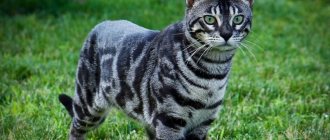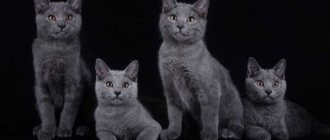Today, almost every family has pets that bring joy to their owners. Cat breeds in Japan are not particularly diverse, but they will certainly surprise many with their cuteness. The absence of a large number of different breeds is explained by the fact that they are simply not selected, preferring everything natural and pristine. In our homeland, as well as throughout the world, people from the Land of the Rising Sun are not particularly popular, since they are not allowed to participate in international exhibitions. But they will certainly make a good choice as pets.
Common Traits of Japanese Breeds
Let's look at this in more detail. Although there are several different types of cats in Japan, they all have certain characteristics that are common to all of them. If you look closely at a photo of a Japanese Bobtail cat or any other cat, you will notice some similarities between them. This is due to the fact that representatives of all breeds are distant relatives. In addition, the following features can be distinguished between them:
- The main breed is the bobtail, and others have been developed through crossbreeding.
- The roots of the breed go back to ancient times.
- All Japanese cats have excellent health.
- Lack of abundance of colors.
- Purely Japanese breeds always have the same eye color. If you find individuals with heterochromia, then these are the creations of American breeders.
- All cats lack a tail, which is their main distinguishing feature.
If you at least once see photos of Japanese cat breeds, you will never be able to confuse them with anyone else. And, as you probably guessed, the point here is not in appearance, but in the absence of a tail. But why don't animals have it? We'll talk about this later.
Reasons for refusing to breed new breeds
As it turned out, such undisguised conservatism is directly related to the cultural and ritual characteristics of the Japanese religion. To say that cats are respected in this country is to say nothing. They really bow down to them here.
Japan even has a Cat Temple, cat museums, figurines of these animals, a god represented in the form of a cat, a talisman in the shape of a cat's silhouette, and a bridge built to their glory. Cats have become characters in many myths, tales and cult parables. However, what is the reason that in Japan, which idolizes these creatures, the selection of new breeds is still not practiced.
The reason is that in the traditional beliefs of this country, a cat should not have a tail. In ancient times, animals with tails were considered to be the offspring of the devil; for the Japanese, tails represented snakes, and they were supposed to be cut off.
If you look closely at the popular maneki-neko figurine (a cat with a paw and a coin raised in greeting), you will notice that it depicts a cat without a tail. And no matter how modern the country becomes, no matter how massively popular furry pets from Europe and America become, a cat, in the conservative view of Japan, will invariably be without a tail.
Reasons for the absence of a tail
Japan is an island nation, and its citizens' tastes are often misunderstood in other countries. This is a unique culture, strange traditions, various beliefs and much more. But why are tailless Japanese cat breeds so popular? It is impossible to answer this question, but we know how they appeared.
For a long time there was an opinion that animals had their tails cut off for a long time, and that subsequently they began to be born without it. However, such a version is unlikely. Scientists adhere to the theory that the main cause is genetic mutations. But they are not any disease or pathology, since animals, unlike many of their other brethren, have good health. Yes, cats do have a tail, but it is very small and more reminiscent of a hare’s.
Description of appearance
The name of the breed speaks for itself: cats do not have a tail in the literal sense of the word. Unlike other bobtails, kittens are always born with a characteristic “piece” for the breed. A cat cannot have a tailed or completely tailless representative in a litter, only a bobtail.
Cats, due to their diversity, have an expanded description of breed characteristics, fixed in the standards:
- body. The Japanese Bobtail is a medium-sized cat, weighing 2-4 kg. Graceful, tall, well-shaped and muscular. The breed exhibits the traits of a real hunter. The limbs are long, strong, the hind legs are higher than the front;
- the head is triangular in shape, with rounded edges. Distinctive straight and long nose. Explicit cheekbones. In profile, the hollows on the cat's cheeks and the soft transition at the base of the forehead are visible. At the same time, the cheeks are small, but clearly visible. Clear and large enough whisker pads. The ears of the Japanese Bobtail are medium in size, oriented forward, with a wide, high set;
- The cat's eyes have a regular oval shape. The large ones are located at an angle to the nose. Wide open. If you look in profile, they may have a hint of orientality, but not expressed;
- wool. The Japanese Bobtail standard provides for the presence of two types of cats in the breed: short-haired and long-haired. At the same time, the adjacent fur of both species is characterized by a thin, almost invisible undercoat. The guard hairs have a silky structure and are soft;
- colors. The Japanese Bobtail can literally be anything. Each color found in nature will fit within the standard;
- tail. A distinctive rock-forming feature is its length. In a calm state, it can be no more than 8 cm. However, there are nuances: the cat’s high-set tail is strongly curved and broken. If you straighten it, the length will reach 15 cm. The hair on the tail is always longer than on the body. It forms a kind of pompom.
Types of breeds
There are not too many breeds of Japanese cats, but there is still some variety. To date, breeders have developed the following:
- Irimoto.
- Snoopy.
- Bobtail.
Outside of Japan, the last two are very popular. Bobtails are even allowed at international cat shows. Let's find out how they managed to win the hearts of millions of people around the world, what they are, and whether it is worth having them in your home.
Cats - with character
Cats, like their human owners, belong to four main temperament groups. Representatives of each breed have their own characteristic features ; they differ from their counterparts in specific behavior, appearance, habits, and attitude towards others.
The “Breeds” section of our website presents a kind of encyclopedia of pets, the characters of which include all breeds of cats with photos and names. Convenient navigation makes it possible to look at all types of cat breeds in the photo, read a brief description, or read a detailed article about the type of animal that interests you.
Contents of information materials in the section:
- The origin of a cat of a particular breed. The historical dossier will tell you about the homeland of the animal you like and the peculiarities of selection.
- Description of the external characteristics of a particular breed: body structure and weight, color, level of hair.
- The texts are supported by photo illustrations of purrs at different ages: from a kitten to an adult animal.
- A detailed overview of the character traits of a cat of a certain breed, which will help you choose a pet with whom you can easily “get along” in your home.
- Tips for caring for each breed of animal, warning about susceptibility to disease.
- Recommendations regarding the diet of pets.
Snoopy
Despite the fact that this breed is considered Japanese, however, it has nothing to do with this country. Its historical homeland and main habitat is China, but it turned out the way it did.
The Japanese Snoopy cat breed has a unique but pretty appearance. They have very funny faces and thick cheeks. The cats are shorthaired and have a rather exotic color called “red tabby van”. The breed appeared in the middle of the 20th century thanks to American breeders by crossing Persians and American Shorthairs.
Characteristic signs
So what do you need to know about this? Representatives of this breed of Japanese cats are noticeably different from their other brothers. They are very friendly, calm and playful. Among the main characteristic external signs are the following:
- expressive brown eyes;
- small ears;
- chubby cheeks;
- very thick and soft wool;
- bushy tail.
But many breeders choose Snoopy not only for his attractiveness. These animals are phlegmatic, so they are very calm and not aggressive. In addition, they have excellent memory and well-developed intelligence.
Bobtail
This breed is a subject of admiration and adoration not only among the Japanese, but also among people all over the world. In its homeland, it is considered rare and prestigious, and it is also believed that these pets bring good luck. The description of the Japanese Bobtail according to the standards is as follows:
- Slim and fit body of medium size;
- the head is shaped like a triangle with smooth curves;
- the muzzle is slightly elongated, with pronounced cheekbones;
- large and forward-leaning ears;
- oval-shaped eyes with different shades;
- long massive paws;
- short and soft wool;
- fluffy tail, the length of which can reach 15 centimeters.
If you look at the photo of the Japanese Bobtail, you will be convinced that this breed is incredibly beautiful. But appearance is not their only advantage. Animals are also distinguished by good health and unpretentiousness, so there are no special problems when caring for them.
Origin story
The Japanese Bobtail is considered a native breed. True, cats were brought to the islands of the Japanese archipelago more than a thousand years ago by the Chinese. Their oriental origin is revealed only by their body structure - elegant and flexible, and the famous wedge characteristic of oriental cats is not so obvious.
Initially, Japanese Bobtails lived in monasteries or in the palaces of wealthy nobility. In the first case, cats protected libraries from rodents, and in the second, they acted as an excellent entertainment for boredom.
Bobtails took to the streets due to a massive invasion of mice. Already in the 16th and 17th centuries, their population increased, and cats could even be found in a semi-wild form. At the same time, the description of the Japanese Bobtail appeared on paper.
The isolation of Japan, due not only to its location, but also to its mentality, played a role in the development of the breed at the international level: enthusiastic felinologists reached the Japanese Bobtail only in the 70s of the last century.
The first kittens were exported to the USA and they marked the beginning of breeding work. The Japanese Bobtail is recognized by leading associations, but still remains the property of Japan: there are few cats of this breed in Europe and the USA.
Character traits
What should you pay attention to first? Japanese Bobtail cats are not like their Snoopy cousins. They are hunters by nature, so their character is simply explosive. Animals catch everything that moves, so a private house is best suited for keeping them. In a city apartment, cats will not have enough physical activity, which will negatively affect their health and behavior.
Another key point to keep in mind when owning bobtails is that they quickly learn bad habits. Therefore, upbringing needs to be done from the very first days, otherwise it will be quite difficult to retrain the cat. As for character, the animals are very friendly not only to adults and children, but also to other four-legged inhabitants. But owners will have to devote a lot of time to their pet, since bobtails are incredibly loyal and need constant communication.
Personality of the Japanese Bobtail
The Japanese Bobtail has an explosive character and is not like an ordinary phlegmatic cat. These pets have very well developed hunting instincts; they catch everything that moves, from rodents and birds to insects. These active cats need constant exercise and a chance to expend their restless energy to avoid behavior problems. They need daily walks on a leash, moving toys, play areas with obstacles for cats, and hanging toys.
These animals quickly learn various habits that are not always good and are difficult to unlearn, so it is important to educate them in time and explain what not to do. Short-tailed pets are very friendly to all family members, and especially to children. Most often, the relationship between a cat and a baby is partnership and playful, less often patronizing.
If there is another pet in the house, then it is important that its temperament matches the choleric Japanese Bobtail. The most dangerous is the union of a bobtail and a ferret, they work like a gang - the ferret is helped by his dexterous paws, thanks to which he can open any door and lock, and the Japanese cat has strength. The same goes for two Japanese bobtails in one house - rest assured, all evil plans will be carried out. The temperament of these animals is similar to that of Abyssinian cats, which are characterized by explosive behavior. If you are attracted to pets that lie peacefully on your lap, then bobtails are definitely not for you.
Japanese Bobtails are very loyal to their owner and follow him everywhere, participating in all activities. At the same time, like children, they absorb everything that a person does, then you can easily meet your pet in a cupboard or washing machine. If this pet watches with curiosity as the owner takes out a bag of garbage from the basket, then later he will definitely try to get to him.
The curiosity and intelligence of these cats help teach them any commands, the main thing is to do it in a playful way. Japanese bobtails understand the word “impossible” very well, but it is almost impossible to dissuade them from their plans, but if you interest the animal in something else and thereby switch it to something else, for example, a walk or active games, then you can avoid damage.
Features of care
This aspect deserves special attention. As noted earlier, the Japanese Bobtail breed is unpretentious and clean. Thanks to their short fur, the animals do not shed and do not need to be brushed frequently. You also don’t have to bathe too often; once or twice a year will be enough.
But the ears should be given more attention. They need to be cleaned every week, because due to their large size, a considerable amount of dirt accumulates in them. In addition, nails should be trimmed regularly. They grow back quickly, so if they are not put in order in time, the animals will experience pain when walking.
The big problem with bobtails is curiosity. They will climb wherever possible. Therefore, you should not leave windows and doors open so that your furry friend does not run out into the street or fall off the windowsill. To distract your animal from everything dangerous and prohibited, you can purchase various cat toys and balls in the store.
As for the toilet, accustoming your pet to sand will not be difficult. Bobtails are distinguished by good intelligence, so they understand that they need to relieve themselves in the litter box, and should not shit in other places. If you live in a private house, then your four-legged friends will spend most of their time outside, where they go to the toilet. And if they feel the urge in the middle of the night, they will wake up the owner and ask to be let out into the garden.
What to feed
So what do you need to know about this? Experts say that the diet of Japanese Bobtail cats should be of high quality and balanced. Therefore, it is better to feed not homemade food, but premium purchased dry food. If you want to start planning the menu yourself, then you need to take into account the fact that cats are carnivorous animals, so meat must be present in their life. But plant foods, which are a source of vitamins, minerals and carbohydrates, are no less important.
When feeding homemade food, it is necessary to add vitamin complexes to it. But it’s still better to stick to dry food, since they are perfectly balanced, contain all the nutrients necessary for normal growth and good health, and will also cost less than buying food in a store.
Breeding
Bobtail and Snoopy cats are ready for mating at the age of one year. However, breeding them is a rather problematic activity. The thing is that these animals are not very common in our country, so finding a suitable partner for a cat in order to get purebred pedigreed kittens is not an easy task. During the search process, you need to consider the following nuances:
- presence of pedigree;
- the length of the tail should not exceed 8 centimeters;
- healthy appearance;
- activity in behavior;
- colors.
If you manage to find a suitable cat that meets all the criteria, then there will be no problems with breeding. Due to their good health, animals give birth on their own without the help of their owner. Mating is possible up to two times a year, and in one litter there can be from 2 to 7 kittens. Cats are very devoted parents, so they do not leave their children a single step, and also provide them with proper care and constant protection.
